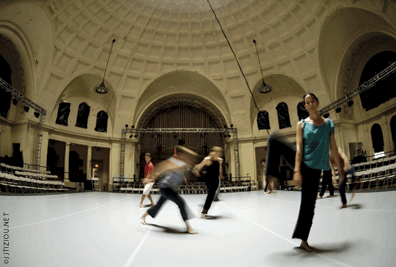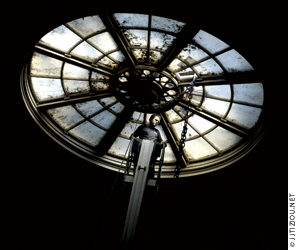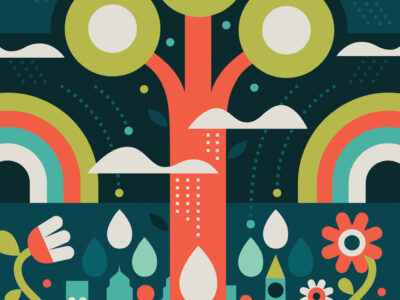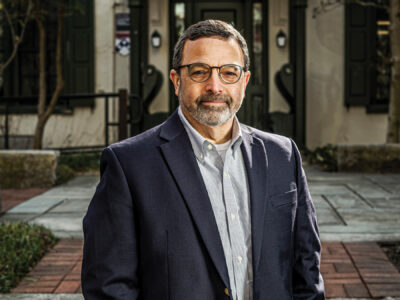
Just a year ago, it was almost unimaginable.
Whatever old pews, chairs, coat hooks, and church debris hadn’t been sold off to architectural salvage firms were scattered around the Rotunda’s cavernous sanctuary, collecting dust and crumbling paint chips fallen from the ceiling.
But on a September night, at the close of the Philadelphia Live Arts Festival, toned dancers from Britain’s Siobhan Davies Dance Company leapt, crawled, and flew through the spectacularly lit room, accompanied by a wordless melody of whistles and clicks in the modern-dance piece Bird Song.
For the first time in more than 20 years, the Rotunda’s celestial domed sanctuary, based on Rome’s Pantheon, was open to the public. Built nearly a century ago as the First Church of Christ Scientist, the Rotunda was used as a church and Sunday school until it was offered to Penn in the wake of the church’s dwindling membership in the 1980s.
It took the University a decade or so to figure out how to best use the building (on the 4000 block of Walnut Street), which is still about a million dollars away from being completely up to code. But now, for the first time ever, the sanctuary is a functioning community arts space, with plans in motion for a grand-sized architectural installation to fill the room with light, sound, and—most important—people.

The revitalization of the Rotunda began nearly a decade ago in urban-studies seminars led by Dr. Ira Harkavy C’70 Gr’79 and Dr. Lee Benson, and has accompanied a cultural renaissance in West Philadelphia. In the coming months, the venue’s rebirth will culminate in an installation by world-renowned Penn architecture professor Cecil Balmond.
“Students got this idea of combining arts and culture, and developing a robust cultural life,” says Harkavy, director of the Center for Community Partnerships, whose academically based community-service courses teach students by giving them real-world problems to solve [“A Matter of Trust,” July/August 2003]. “It would incorporate learning from and with the community, and would develop as something that would benefit both Penn and the community.”
Harkavy and Benson’s courses soon gave birth to the Foundation Community Arts Initiative, which currently hosts 200 music, art, dance, theater, and cultural events a year in the Rotunda’s more modest back room. The Foundation put the Rotunda on the city’s arts- and-culture map as a free, all-ages provider of diverse, entertaining programming.
But while the back room flourished, the building’s dilapidated sanctuary lay dormant—until Cecil Balmond and Andrew Zitcer C’00 GCP ‘04 figured out how to put it to use.
Zitcer, who works as cultural asset manager for facilities and real estate services, first came to the Rotunda as a student in Harkavy and Benson’s seminars. He later launched the Foundation and oversaw its programming until current executive director Gina Renzi took over in 2002.
Zitcer was the one who gave Balmond his first tour of the building. It happened to coincide with a tour given to a local yoga teacher who was interested in hosting classes there. For Zitcer, the interaction between the professor and the yoga instructor embodied the Rotunda’s potential as a community arts space.
“[Balmond] began to walk through this place with her, and they started talking about the chakras,” or energy centers within the body, Zitcer says. “He’s infatuated and obsessed with the number nine. She started to talk about the nine chakras, and he started to talk about the number nine in his theory of numerological combinatorics.
“They began to mutually riff off each other about the Rotunda, and I realized this would really work, because he could talk to people about what he’s doing, people who had literally walked in off the street,” Zitcer says.
The installation’s design—mathematically derived from the nine-times multiplication table, which was then mapped onto a sphere representing the Rotunda sanctuary—was inspired by work done by Balmond’s students. Once final costs are determined and funding for the project is secured, the finished piece will be a combination of lights and sound traveling across tubes zigzagging through the room at precisely determined angles and distances.
Balmond envisions the work as a three-act opera for all the senses. “It’s not what you look at—it’s something you feel,” says the Sri Lankan-born Balmond, whose London-based structural-engineering firm is responsible for buildings worldwide from the Sydney Opera House to the Victoria and Albert Museum. “It’s not just a light installation—it’s a piece of architecture. It’s architecture seen as light, and ideally as sound.”
After tweaking the design over the summer and finally reaching a point where he’s happy with it, Balmond is ready to move ahead with the installation. If all goes according to plan, the project should help generate funding to restore the sanctuary to its original brilliance, and cement the Rotunda’s status as a community arts hub.
“There are so many people involved in the Rotunda—staff, volunteers and others—that we’re always cross-pollinating our events,” says Rashida Holmes C’94 CGS’04, whose Girls’ DJ 101 classes, which teach women the fundamentals of record-spinning, are among a slew of regular events held in the Rotunda’s back room. “It’s a really supportive system of local artists and community activists that we’re able to tap into and draw from.”
And that university/community synergy hasn’t gone unnoticed.
“It was only after the Foundation and its success that we and members of the community saw the full potential,” says Harkavy. “If it weren’t for the Foundation, I don’t think we would have moved ahead in any way, shape, or form with the subsequent seminars that looked at the Rotunda.”
“Being University-funded but community driven, this is one of the best marketing tools for Penn’s community outreach,” says the Rotunda’s Renzi. “Whether community means West Philly or Philadelphia in general, there’s no other space in the country that’s quite like this.”
—Jeffrey Barg C’02




